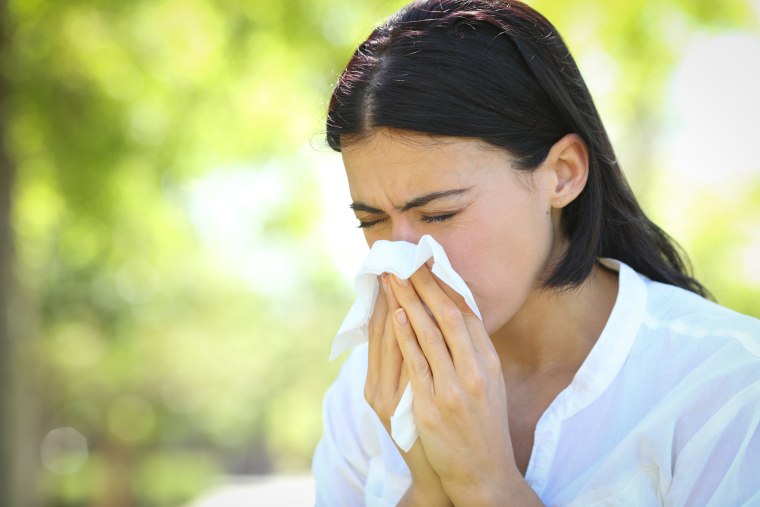After retreating during the pandemic, colds are back in full force in some parts of the U.S. this summer.
Rhinoviruses — the most frequent cause of the common cold — circulate year-round, but summer gatherings such as weddings, barbecues and graduations may have accelerated their spread, according to disease experts.
"It’s ridiculous how much you see it in the summer," Dr. Michelle Barron, senior medical director of infection prevention and control at UCHealth in Colorado, said of rhinovirus.
On top of that, the U.S. is seeing a considerable uptick in adenovirus infections, according to data from the Centers for Disease Control and Prevention. Adenoviruses usually cause mild respiratory illness, including common cold symptoms such as fever or sore throat. The viruses can also cause pink eye, diarrhea and skin rashes.
"Since summer 2021, we have seen a steady increase in respiratory adenovirus activity compared to earlier in the pandemic, and currently, activity is higher than during the same period of time in 2022. However, these levels appear to be plateauing,” Kathleen Conley, a public affairs specialist at the CDC, said via email.
She added that adenovirus activity "remains within the range expected for this time of year," and that many other respiratory viruses have similarly reverted to pre-pandemic numbers.
"Earlier this year, we saw a return to similar levels observed for many of these viruses prior to 2020," Conley said.
Data from the Seattle Flu Study, a project that tracks the prevalence of respiratory illnesses among symptomatic people in King County, Washington, suggests that adenovirus cases are unusually high this summer.
In early June, an estimated 25% of people in that study who were infected with a respiratory pathogen and had symptoms tested positive for adenovirus. That's higher than the summer 2019 peak, when 17% tested positive, and far higher than levels recorded in 2020, 2021 or 2022.
"There is definitely more adenovirus at the moment than usual," said Dr. Ana Weil, a principal investigator at the Seattle Flu Alliance, which runs the Seattle Flu Study, and an assistant professor of allergy and infectious diseases at the University of Washington School of Medicine.
Rhinovirus represented 33% of symptomatic respiratory illnesses in King County in early June, according to the Seattle Flu Study. But that was consistent with levels recorded before the pandemic.
Covid, meanwhile, made up just 2% of symptomatic respiratory illnesses in the study. Although the CDC no longer tracks Covid cases, hospitalizations have steadily declined since the start of the year. The CDC recorded fewer than 6,400 new weekly Covid hospitalizations in mid-June, compared to more than 44,000 in early January.
UCHealth said it has also seen an uptick in adenovirus infections. But several other health systems — in Connecticut, Maryland, Massachusetts, New York, North Carolina and Pennsylvania — said they weren’t seeing any notable increases in colds or other respiratory illnesses.
"There’s often quite a bit of regional variety. But whereas last year, we had quite a lot of adenovirus and parainfluenza at this stage, that hasn’t really surfaced yet," Dr. Cameron Wolfe, an infectious disease specialist at Duke Health, said in an email.
Colds have become less predictable
Respiratory viruses typically circulate from winter to spring, but the pandemic disrupted that seasonal pattern, making it difficult to anticipate new waves of infections.
"A few years of people not being exposed and not building up immunity has led to a situation where it’s much harder to predict what the seasonality is going to be and when we expect to see surges of things," Weil said.
She added that waning immunity could also make cold symptoms more severe, though she noted that there isn’t data to support that hypothesis yet.
Immunity to most respiratory viruses usually only lasts a couple of months, so it's not surprising that some people are getting sick right now, Barron said.
"We forgot that summer colds are actually pretty common," she said.
How to prevent summer colds from spreading
In general, experts said, summer colds should start to resolve within a few days.
People who develop a fever three or four days after their symptoms start — or whose symptoms get worse around that time — should see a doctor, since it may be a sign of a secondary infection such as sinusitis or pneumonia, Barron said.
"Usually after three or four days, you should be beyond whatever you have," she said. "You still may have some symptoms, but they should be improving."
Both rhinovirus and adenovirus spread through respiratory droplets from coughs or sneezes, so hand-washing and masks can help limit transmission.
The viruses also spread via surfaces, Barron said, so it’s important to change out hand towels and disinfect doorknobs, sink handles and refrigerator handles if someone in your home is sick.

